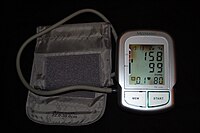
Photo from wikipedia
Purpose This study sought to determine the associations of co-existing hypertension and hyperhomocysteinemia (H-Hcy) with carotid vulnerable plaque features and subsequent vascular events. Methods Symptomatic patients with carotid atherosclerosis were… Click to show full abstract
Purpose This study sought to determine the associations of co-existing hypertension and hyperhomocysteinemia (H-Hcy) with carotid vulnerable plaque features and subsequent vascular events. Methods Symptomatic patients with carotid atherosclerosis were enrolled and underwent carotid magnetic resonance (MR) vessel wall imaging. The patients were divided into the following groups: co-existing hypertension and H-Hcy group; isolated hypertension group; isolated H-Hcy group; and control group. The morphological and compositional characteristics of carotid plaques were assessed on MR images and compared among different groups. Univariate and multivariate cox regressions were used to calculate the hazard ratio (HR) and corresponding 95% confidence interval (CI) of co-existing hypertension and H-Hcy in predicting subsequent vascular events after at least 1-year followed-up. Results In total, 217 patients (mean age, 59.4 ± 11.9 years; 154 males) were recruited. Patients in co-existing hypertension and H-Hcy group had a significantly higher prevalence of carotid lipid-rich necrotic core (LRNC) than isolated H-Hcy and control group (73.2 vs. 43.3 vs. 50%, p = 0.015). During the median follow-up time of 12.2 ± 4.3 months, 61 (39.8%) patients experienced vascular events. After adjusting for baseline confounding factors, co-existing hypertension and H-Hcy (HR, 1.82; 95% CI, 1.01–3.27; p = 0.044), presence of carotid LRNC (HR, 2.25; 95% CI, 1.09–4.65; p = 0.029), and combination of co-existing hypertension and H-Hcy and carotid LRNC (HR, 2.39; 95% CI, 1.26–4.43; p = 0.007) were significantly associated with subsequent vascular events. Conclusions Co-existing hypertension and H-Hcy are associated with carotid vulnerable plaque features, such as LRNC. Combining co-existing hypertension and H-Hcy with carotid vulnerable plaque features has a stronger predictive value for subsequent vascular events than each measurement alone.
Journal Title: Frontiers in Cardiovascular Medicine
Year Published: 2022
Link to full text (if available)
Share on Social Media: Sign Up to like & get
recommendations!